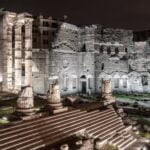Italy has long been synonymous with mouthwatering cuisine, stunning landscapes, and rich history. But for wine enthusiasts, Italy offers an even more enticing draw: its unrivaled wine culture. Traveling to Italy for wine tours allows visitors to indulge in the delicious world of Italian wines while immersing themselves in the country’s captivating traditions and landscapes. Whether you’re a seasoned sommelier or simply appreciate a good glass of vino, a wine tour in Italy promises an unforgettable experience.
With a winemaking history that dates back thousands of years, Italy boasts countless vineyards and wineries that produce some of the finest wines in the world. From ancient grape varieties to modern winemaking techniques, the country’s viticultural practices have evolved over time, resulting in a diverse array of flavors and styles. Exploring the fascinating history of wine in Italy is like embarking on a journey through time, where every sip tells a story.
But it’s not just about the past; Italy’s top wine regions continue to thrive and surprise even the most discerning palates. From Piedmont’s renowned Barolo wines to Tuscany’s iconic Chianti Classico, there are hidden gems waiting to be discovered all across the country.
Each region boasts its own unique terroir, microclimate, and grape varieties, offering endless opportunities for exploration and appreciation. So grab your passport and prepare for an adventure that will tantalize your taste buds and ignite your passion for Italian wines.
The history of wine in Italy
Italy has a rich and storied history when it comes to wine production. From ancient times to modern winemaking techniques, the country has been at the forefront of viticulture and oenology. Understanding the historical context of Italy’s wine industry can enhance your appreciation for the country’s diverse and high-quality wines.
- Ancient Origins: Wine production in Italy dates back thousands of years, with evidence of vine cultivation and winemaking techniques being practiced by early civilizations such as the Etruscans and Greeks. The Romans, in particular, played a significant role in shaping Italy’s wine culture, spreading vineyards throughout their empire and perfecting winemaking methods.
- The Influence of Monasteries: During the Middle Ages, monasteries played a crucial role in preserving grape varieties and advancing winemaking practices. Monks not only cultivated vines but also recorded their observations and experiments, contributing to the growth and improvement of Italian wines.
- Modern Winemaking Techniques: In recent centuries, advancements in technology and scientific understanding have revolutionized Italy’s wine industry. From improved vineyard management techniques to innovative fermentation processes, winemakers today have access to tools that allow them to produce wines of exceptional quality while still honoring traditional methods.
Today, Italy is known for its diverse regional wine styles, each reflecting unique terroirs, grape varieties, and winemaking traditions. Exploring the history behind Italian winemaking offers insights into how these regional specialties have developed over time and helps visitors appreciate the passion and dedication that go into producing each bottle.
- Etruscans.
- Greeks.
- Romans.
- Middle Ages monks.
- Modern advancements.
Top wine regions in Italy
Italy is renowned for its diverse wine regions, each offering unique flavors and grape varieties. For wine enthusiasts, exploring the top wine regions in Italy is a must-do on their journey to discover the hidden gems of Italian winemaking. From Tuscany to Piemonte, here are some of the top wine regions in Italy:
- Tuscany: Tuscany is known for its iconic red wines, particularly Chianti and Brunello di Montalcino. With picturesque landscapes of rolling hills and vineyards, it’s no wonder that this region has become a favorite among wine lovers. The Sangiovese grape variety thrives in this area, producing bold and complex wines.
- Piemonte: Located in northwest Italy, Piemonte is known for producing some of the country’s most prestigious wines. Barolo and Barbaresco are two famous red wines made from the Nebbiolo grape variety, which grows exceptionally well in this region’s hilly terrain. The Langhe district in Piemonte is also recognized as a UNESCO World Heritage site.
- Veneto: Veneto is home to one of Italy’s most famous sparkling wines, Prosecco. This region is also known for producing other quality white wines such as Soave and Pinot Grigio. A visit to Veneto offers not only excellent wines but also stunning views of the countryside and historical cities like Verona and Venice.
In addition to these three regions, there are many other lesser-known gems waiting to be discovered by wine enthusiasts traveling to Italy. These include Piedmont’s lesser-known neighbor Lombardy, Sicily with its volcanic soils producing vibrant reds and whites, as well as Campania where ancient grape varieties like Aglianico thrive.
When planning your trip to these top wine regions in Italy, keep in mind that different parts of the country have their own distinct climates and microclimates, leading to variations in grape varieties and wine styles. It is always a good idea to research and plan ahead to make the most of your time in each region and ensure you don’t miss out on any hidden gems.
Table
| Wine Region | Famous Wines | Main Grape Varieties |
|---|---|---|
| Tuscany | Chianti, Brunello di Montalcino | Sangiovese |
| Piemonte | Barolo, Barbaresco | Nebbiolo |
| Veneto | Prosecco, Soave, Pinot Grigio | Glera (Prosecco), Garganega (Soave), Pinot Grigio (Pinot Grigio) |
Planning your wine tour
Planning your wine tour to Italy is an exciting endeavor, but there are a few important tips and considerations to keep in mind in order to ensure a seamless trip. First and foremost, it’s essential to determine which wine regions you want to visit. Italy has numerous renowned wine regions, each offering unique experiences and specialties. Whether you choose Tuscany, Piedmont, or the Veneto region, make sure to research the wineries and vineyards that align with your preferences.
Once you have selected your desired wine regions, it’s time to plan your itinerary. Consider the duration of your trip and allow enough time in each region to fully immerse yourself in its wine culture.
It’s also advisable to make reservations for winery visits and tastings in advance, especially if you plan on visiting popular or well-known wineries. Many wineries offer different tasting options, from basic tastings to guided tours and food pairings, so take this into account when planning your schedule.
Transportation is another crucial aspect of planning your wine tour in Italy. Renting a car is often the most convenient option as it allows you flexibility and freedom to explore different regions at your own pace. However, if you prefer not to drive, there are train options available between major cities and towns in Italy’s wine regions. Additionally, consider hiring a private driver or joining organized tours that cater specifically to wine enthusiasts.
Lastly, don’t forget about accommodations and dining arrangements. Some wineries offer on-site accommodations, providing an immersive experience right in the heart of the vineyards. Alternatively, there are charming agriturismos (farmhouse stays) or boutique hotels located near the wineries that can enhance your stay. As for dining, indulge in traditional Italian cuisine paired with local wines at agriturismos or local restaurants known for their culinary expertise.
With careful planning and consideration of these tips, you can ensure a seamless trip as you embark on your wine tour in Italy. Keep in mind that flexibility is key, as sometimes the most unforgettable experiences can occur when you least expect them. So sip, savor, and enjoy all that Italy’s wine culture has to offer.
Must-visit wineries in Italy
Italy is home to some of the most renowned wineries in the world, offering wine enthusiasts the opportunity to indulge in immersive and unforgettable experiences. From picturesque vineyards nestled in rolling hills to historic cellars filled with aging barrels, visiting these must-visit wineries is a highlight of any wine tour in Italy.
- Castello di Volpaia, Tuscany: Situated in the heart of Chianti Classico region, Castello di Volpaia is a medieval castle-turned-winery that dates back to the 11th century. The estate spans over 40 hectares and produces exceptional Sangiovese-based wines. Visitors can tour the castle’s cellars and production facilities, participate in tastings, and even take part in cooking classes or truffle hunting.
- Antinori nel Chianti Classico, Tuscany: This iconic winery combines traditional winemaking techniques with contemporary architecture. With a history dating back over 600 years, visitors can explore their state-of-the-art cellar and enjoy tastings of their renowned Super Tuscan wines. The breathtaking views of vineyards and olive groves from the tasting room make it an unforgettable experience.
- Marchesi Antinori, Umbria: Founded by the Antinori family in 1385, this winery combines centuries-old traditions with innovative approaches to winemaking. Located in Umbria’s countryside, visitors can take guided tours through the vineyards and cellars before indulging in tastings of their acclaimed wines like Tignanello and Solaia.
- Barone Ricasoli, Tuscany: Established by Baron Bettino Ricasoli in 1141, this is one of Italy’s oldest wineries with a rich history linked to the creation of Chianti Classico wine. Guests can explore the castle grounds, including picturesque gardens and ancient cellars where Chianti Classico was first produced. Tastings of their award-winning wines accompanied by local food specialties are not to be missed.
To make the most of your wine tour in Italy, it is advisable to contact wineries in advance to schedule visits and inquire about tour options. Additionally, consider hiring a local guide or joining organized tours that provide transportation between wineries, ensuring a seamless and enjoyable experience. Remember to check for any specific requirements such as dress codes or reservation policies before visiting these must-visit wineries in Italy.
Tasting Italy’s finest wines
Italy is renowned for its diverse and high-quality wines, each region having its own unique specialties and grape varieties. Tasting Italy’s finest wines is an essential part of any wine tour in the country. This section will provide a guide to the regional specialties and grape varieties that wine enthusiasts should not miss.
In Northern Italy, the region of Piedmont is famous for producing some of Italy’s most prestigious wines. Barolo, made from the Nebbiolo grape, is known as the “King of Wines” due to its complexity and longevity. Another notable red wine from Piedmont is Barbaresco, also made from Nebbiolo grapes. These wines are characterized by their intense flavors of cherry, licorice, and truffle.
Moving towards Central Italy, Tuscany stands out as a prominent wine region. Chianti, made primarily from Sangiovese grapes, is one of Italy’s best-known red wines. With its medium body and notes of dark cherry and earthy herbs, Chianti perfectly embodies the traditional Italian winemaking style. Other famous Tuscan reds include Brunello di Montalcino and Vino Nobile di Montepulciano.
In Southern Italy, Sicily shines as a burgeoning wine region offering a mix of indigenous and international grape varieties. Nero d’Avola is the most famous red wine from Sicily, known for its full-bodied nature, dark fruit flavors, and hints of spice. Additionally, Etna Rosso showcases the unique volcanic terroir of Mount Etna with its elegant structure and pronounced minerality.
To fully appreciate Italy’s diverse grape varieties and regional specialties during your wine tour, it is recommended to visit different wineries across the country. This allows you to explore not only different styles of winemaking but also immerse yourself in the rich history and culture surrounding Italian wines.
| Region | Grape Varieties | Specialties |
|---|---|---|
| Piedmont | Nebbiolo, Barbera, Dolcetto | Barolo, Barbaresco, Asti Spumante |
| Tuscany | Sangiovese, Cabernet Sauvignon, Merlot | Chianti, Brunello di Montalcino, Super Tuscans |
| Sicily | Nero d’Avola, Nerello Mascalese, Catarratto | Etna Rosso, Marsala, Grillo |
Wine and culinary fusion
Italian cuisine is renowned worldwide for its rich flavors, fresh ingredients, and exquisite pairings with wine. When traveling to Italy for a wine tour, one cannot miss the opportunity to explore the perfect match between regional specialties and indigenous grape varieties. This section will delve into the art of food and wine pairing in Italy, as well as highlight some traditional Italian dishes that perfectly complement the country’s finest wines.
Understanding Food and Wine Pairing
In Italy, food and wine are seen as inseparable companions. The key to successful pairings lies in finding harmony between the flavors, textures, and aromas of both elements. Regional cuisines vary greatly across Italy due to its diverse landscape and culinary traditions. Each region provides unique flavor profiles that can either enhance or compete with particular styles of wine.
One rule of thumb in Italian gastronomy is to pair local regional dishes with wines produced in that specific area. For example, Tuscan Chianti Classico pairs exceptionally well with Tuscany’s hearty dishes like bistecca alla Fiorentina (Florentine-style steak) or pappardelle al ragù di cinghiale (pappardelle pasta with wild boar ragu). These combinations create a sensory experience where each bite harmonizes magnificently with each sip.
Traditional Italian Dishes That Enhance Wine
Italy boasts an array of traditional dishes that have been perfected over centuries, enticing food lovers from around the world. Here are a few classic examples that beautifully complement Italian wines:
- Risotto alla Milanese: A creamy saffron-infused risotto from Milan served alongside a dry white wine like Gavi di Gavi or Lugana.
- Spaghetti alla Carbonara: A Roman specialty consisting of pasta tossed in a creamy egg-based sauce with crispy pancetta or guanciale. Pair it with a medium-bodied red wine such as Barbera d’Asti or Montepulciano d’Abruzzo.
- Caprese Salad: A simple yet delightful combination of fresh buffalo mozzarella, ripe tomatoes, and basil leaves drizzled with extra virgin olive oil. This dish is a perfect match for wines like Vermentino di Gallura or Frascati.
These are just a few examples among the myriad of traditional Italian dishes that beautifully enhance the experience of wine tasting in Italy. Exploring the local gastronomy alongside their respective regional wines will give travelers an authentic understanding of the country’s rich cultural heritage.
By indulging in these culinary delights and exploring food and wine pairings during your wine tour in Italy, you will not only satisfy your taste buds but also deepen your appreciation for both the artistry behind winemaking and the gastronomic treasures this beautiful country has to offer.
Beyond the vineyards
Italy is not only famous for its wine, but also for its rich history, stunning landscapes, and vibrant culture. As you plan your wine tour in Italy, take some time to explore the various attractions and activities that go beyond the vineyards. Whether you are a history buff, a nature lover, or a food enthusiast, there is something for everyone to enhance their wine tour experience.
Exploring Italy’s Historic Sites
Italy is home to numerous historic sites that are worth a visit during your wine tour. From ancient Roman ruins to medieval castles, these landmarks offer a fascinating glimpse into the country’s past. Plan a day trip to Rome and explore iconic sites such as the Colosseum and Roman Forum.
In Tuscany, visit the charming city of Florence to admire Renaissance architecture and artworks at the Uffizi Gallery. For those interested in ancient history, don’t miss Pompeii near Naples, where you can see well-preserved ruins of an entire Roman city buried by Mount Vesuvius in 79 AD.
Embracing Nature’s Beauty
Italy is blessed with breathtaking natural landscapes that provide a perfect backdrop for your wine tour. Head to the Lake District in northern Italy and indulge in picturesque views of crystal-clear lakes surrounded by majestic mountains.
The Amalfi Coast in southern Italy offers stunning coastal scenery: rugged cliffs, colorful houses perched on hillsides, and sparkling turquoise waters. If you are looking for outdoor adventures, explore the Cinque Terre National Park on the Ligurian coast or hike through the vineyard-covered hills of Piedmont.
Delving into Italian Cuisine
No wine tour in Italy would be complete without savoring its delicious cuisine. Italian food goes far beyond pizza and pasta; it encompasses diverse regional specialties that pair perfectly with local wines. Indulge in authentic flavors by trying dishes like risotto in the Lombardy region, cannoli in Sicily, or fresh seafood along the coast. Consider taking a cooking class to learn how to prepare traditional Italian dishes and bring the flavors of Italy back home with you.
By incorporating these attractions and activities into your wine tour itinerary, you can create a truly unforgettable experience. Whether you’re exploring historic sites, immersing yourself in nature’s beauty, or indulging in Italian cuisine, these additional elements will enhance your appreciation for Italy’s wine culture and make your trip even more remarkable.
Traveling sustainably
In recent years, there has been a growing emphasis on sustainable travel and responsible tourism practices. When it comes to wine tours in Italy, it is no different. Traveling sustainably means supporting wineries that prioritize eco-friendly practices and taking steps to minimize the impact on the environment. This final section will explore how you can contribute to sustainable wine tourism in Italy.
One of the ways you can support eco-friendly wineries is by choosing organic or biodynamic wines. These wines are produced without the use of synthetic chemicals, pesticides, or fertilizers, promoting healthier soils and biodiversity. Look for wineries that have obtained organic certifications or follow biodynamic principles. By buying and tasting these wines, you are not only supporting sustainable agriculture but also experiencing a unique taste of Italy’s commitment to environmental stewardship.
In addition to choosing eco-friendly wines, it is important to be mindful of your overall carbon footprint when traveling to Italy for a wine tour. Consider using public transportation whenever possible or opt for shared transportation services instead of renting a car. Reduce water usage by taking shorter showers and reusing towels at your accommodations. Support local businesses and restaurants that prioritize locally sourced ingredients and sustainable food practices.
As responsible tourists, we have the power to make a positive impact on the regions we visit. By traveling sustainably and supporting eco-friendly wineries in Italy, we can help protect the environment while enjoying all that this beautiful country has to offer. So go ahead, book your wine tour with consciousness and savor not just the exquisite taste of Italian wines but also the knowledge that you are contributing towards a greener future for wine tourism.
Frequently Asked Questions
How do I plan a wine tour in Italy?
Planning a wine tour in Italy can be an exciting and rewarding experience. To start, it’s important to decide which wine regions you want to visit. Italy has numerous renowned wine regions such as Tuscany, Piedmont, Veneto, and Sicily, each offering unique varietals and landscapes. Research the wineries in your chosen region and create a rough itinerary based on the ones you’d like to visit.
Consider factors like the type of wines produced, the winery’s reputation, and any specific experiences they offer (such as vineyard tours or tastings). It can also be helpful to organize transportation in advance, whether it’s renting a car or hiring a driver/guide. Additionally, make sure to check the opening hours of the wineries and consider booking appointments for tastings or tours if required. Lastly, don’t forget to factor in time for exploring nearby attractions, enjoying local cuisine, and immersing yourself in the rich Italian culture.
Do you need reservations for wineries in Italy?
While some wineries in Italy allow walk-ins for tastings and tours, it’s generally advisable to make reservations ahead of time. Making reservations ensures that your desired winery will be expecting you and have staff available to guide you through their offerings. This is especially true for smaller boutique wineries that may have limited spaces available or require appointments due to production schedules.
By making reservations beforehand, you can also customize your experience with additional services like private tastings or food pairings if they are offered by the winery. So even though some wineries may accommodate unannounced visitors during less busy periods, it is always safer to call ahead or book online to secure your spot.
What is the best wine region in Italy?
Determining the best wine region in Italy is subjective as each region offers distinct wines and experiences that cater to different preferences. However, one of the most well-known and highly regarded wine regions is Tuscany. Famous for its Chianti Classico, Brunello di Montalcino, and Super Tuscans, Tuscany boasts a beautiful landscape of rolling hills and picturesque vineyards. It also provides a rich cultural heritage with charming medieval towns like Siena and San Gimignano.
Another notable wine region is Piedmont in northwest Italy, which is renowned for its elegant Barolo and Barbaresco wines crafted from the Nebbiolo grape. The region’s stunning scenery, which includes rolling vineyard-covered hills around Alba, coupled with its truffle-rich cuisine make it an attractive destination for wine enthusiasts. Ultimately, the best wine region in Italy will depend on your personal taste preferences and the type of experience you are seeking.

I’m a passionate traveler, writer, and Italophile. My fascination with Italy’s history, art, and culture has led me on countless adventures across the Italian landscape. Through “I Live Italy,” I share my love for this extraordinary country and aims to inspire others to explore its boundless beauty.





